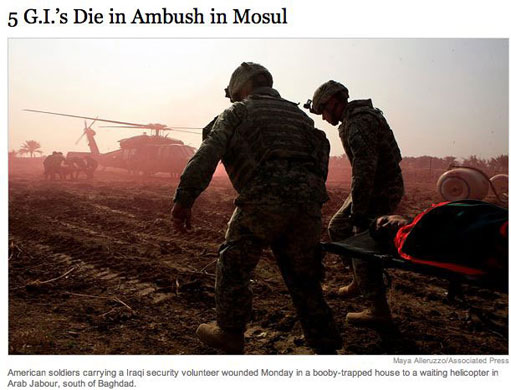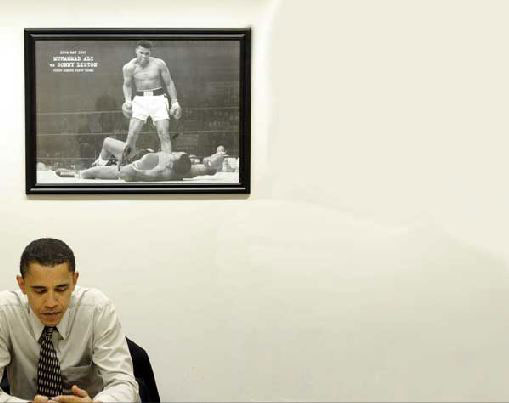Notes
The Futility Of The Iraq War Picture (Or: Bombs Away, Far Away)

The more I look at and think about this image, accompanying a NYT war update a little over a week ago, the more questions it raises. For example:
>> If the photo was taken in Arab Jabour, south of Baghdad, what is it doing illustrating a story about Mosul, to the north?
>> The caption names the location, but the scene has more a sense of the outskirts than a specific town.
>> With the U.S. soldiers apparently departing a conflict zone – and, given the wounded Iraqi is “split in half” — the image more than leaves hanging exactly “what went on back there?”
The question of what is or isn’t happening, however — just like the disconnection between the setting of the photo and the setting of the article — does, in fact, fill us in on something very important about the war. What it shows us is how little connection exists between the war news and the war pictures, and how little continuity carries over from one war report to the next.
Picking up on this quality, a post a week ago at AfterDowningStreet looked at how recent media reports from Iraq have been not just highly selective, but myopic in detail. David Swanson’s post called out two recent MSM stories, one from the LA Times, the other from the NY Times, dealing with particular suicide bombings or IED attacks. Although either buried or just casually noted, the common denominator Swanson found was the matter-of-fact reference to intense American bombing.
Through these two “routine” stories, Swanson shines a light on the fact that American forces, between January 11 and 21, dropped 100,000 pounds of explosives on Arab Jabour, this farming town south of Baghdad, in the hopes of destroying weapons caches and IED’s. Quoting the ADS post (regarding the two newspaper pieces):
Neither paper has (as far as I know) returned to the subject [of bombing], though this is undoubtedly the most extensive use of air power in Iraq since the Bush administration’s invasion of 2003 and probably represents a genuine shifting of American military strategy in that country. Despite a few humdrum wire service pieces, no place else in the mainstream has bothered to cover the story adequately either.
Which leads me back to the image and the NYT article that accompanied it — the photo taken one week after this bombing stretch. Out of 18 paragraphs, the first 12 refer to fierce fighting in Mosul between insurgents and out-manned U.S. forces, and the last six deal with an arson fire in Baghdad. Beyond the caption, however, nowhere is there mention of Arab Jabour.
Beyond this pretty and heroic picture, taken at dusk (or in dawn’s early light), there lie themes much more complicated than rescue. What emerges, as I mention, is the significance of what isn’t or can’t be see. And, along those lines, I’m wondering just how much the U.S. bombings here might be the elephant in the room.
Consider a report from Presscue, for example (also compiled by piecing together stray news reports), indicating that Americans invited families to return to Arab Jabour before beginning the bombing campaign, insisting that American and Awakening forces had succeeded in rooting out the insurgents. Contradicting military claims that no casualties were suffered, Sunni politicians claimed 500 casualties, mostly women and children.
“Try dropping 100,000 pounds bombs on Syracuse, New York, which has a similar population, and see if you get no casualties,” a Sunni politician, who wished to remain anonymous on the grounds that US-trained death-squads target politicians who criticize American military action, said. “This is a return to the indiscriminate bombing we witnessed at the beginning of the invasion in 2003. They are happy to kill as many civilians as it takes to minimize risks for the US soldiers.”
Operating in this same sketchy, piecemeal, blind-man-and-the-elephant environment for information, the best I can do with a shot like this is to remember to ask what is “back there.” Beyond that, it is worthwhile to note how much these random, exclusionary photos and news reports actually indictment themselves.
Whoever and however many are getting pulverized outside this viewing window, what this visual offers is a horrible snapshot of meaning, itself, being blown to bits.
5 G.I.’s Die in Ambush in Mosul (NYT)
Looking Up: Normalizing Air War from Guernica to Arab Jabour (Afterdowningstreet.org)
U.S. forces invite families back to Arab Jabour before bombing them (Presscue)
(Maya Alleruzzo/A.P. Arab Jabour. January 28, 2008. nytimes.com)


Reactions
Comments Powered by Disqus